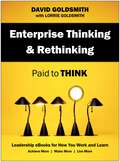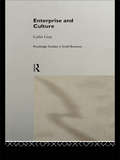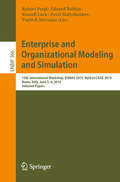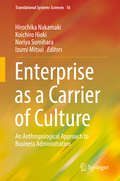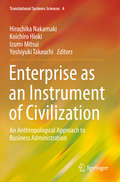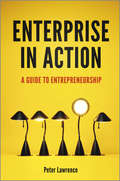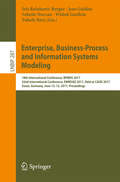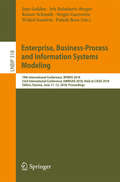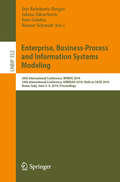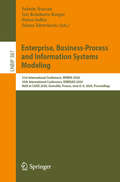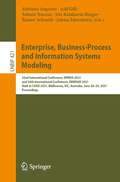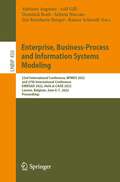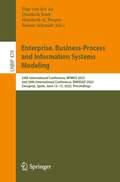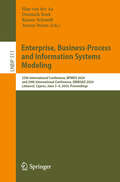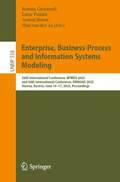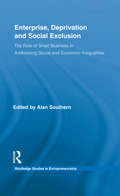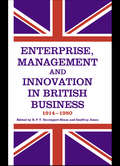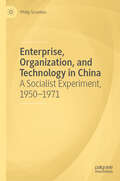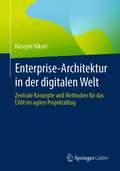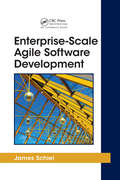- Table View
- List View
Enterprise Thinking & Rethinking: Paid to Think
by David GoldsmithUnderstand your true value to your organization by escaping self-limiting beliefs and learning about the 12 daily leadership activities that will enable you to more effectively lead others to desired outcomes and improve your performance as a leader and manager.
Enterprise and Culture (Routledge Studies in Entrepreneurship and Small Business #Vol. 4)
by Colin GrayEnterprise and Culture is a uniquely wide-ranging, insightful and well-informed critical evaluation of the economic and social project of creating an enterprise culture.Colin Gray argues that the failure of small enterprise policy is not just a question of economics, but is also caused by psychological and cultural factors. The book demonstrates that the individualism at the centre of enterprise culture policies is, itself, the main impediment to the successful growth and development of small enterprises.
Enterprise and Organizational Modeling and Simulation: 15th International Workshop, EOMAS 2019, Held at CAiSE 2019, Rome, Italy, June 3–4, 2019, Selected Papers (Lecture Notes in Business Information Processing #366)
by Eduard Babkin Robert Pergl Russell Lock Pavel Malyzhenkov Vojtěch MerunkaThis book constitutes the refereed proceedings of the 15th International Workshop on Enterprise and Organizational Modeling and Simulation, EOMAS 2019, held in Rome, Italy, in June 2019. The main focus of EOMAS is on the role, importance, and application of modeling and simulation within the extended organizational and enterprise context. The 12 full papers presented in this volume were carefully reviewed and selected from 25 submissions. They were organized in topical sections on conceptual modeling, enterprise engineering, and formal methods.
Enterprise and Trade in Victorian Britain: Essays in Historical Economics
by D. N. McCloskeyThe essays in this book focus on the controversies concerning Britain's economic performance between the mid-nineteenth century and the First World War. The overriding theme is that Britain's own resources were consistently more productive, more resilient and more successful than is normally assumed. And if the economy's achievement was considerable, the influence on it of external factors (trade, international competition, policy) were much less significant than is normally supposed. The book is structured as follows: Part One: The Method of Historical Economics Part Two: Enterprise in Late Victorian Britain Part Three: Britain in the World Economy, 1846-1913.
Enterprise and Welfare Reform in Communist Asia
by Peter Ferdinand Martin GainsboroughFeaturing a wide geographical scope, this collection of essays surveys enterprise and welfare reforms in all the remaining four Asian communist states: China, Vietnam, Laos and North Korea. Since the collapse of the Soviet Union they can no longer place major reliance upon assistance from other 'fraternal' states and have to devise their own strategies for survival. All have shown a trend towards greater reliance on market forces, though in different ways and to varying degrees. Enterprise management has to adapt to this. In some of them entrepreneurs have become politically and socially acceptable. They may even begin to set trends for social evolution. Yet since state entreprises used to be responsible for all welfare payments to employees and their families, management reforms cannot be separated from those of welfare arrangements. Reducing an enterprise's non-commerical obligations for the sake of greater market efficiency is bound to affect welfare provision. It also reopens the role of official trade unions. How these regimes cope with these conflicting pressures are vital factors in their long-term viability.
Enterprise as a Carrier of Culture: An Anthropological Approach to Business Administration (Translational Systems Sciences #16)
by Hirochika Nakamaki Koichiro Hioki Izumi Mitsui Noriya SumiharaThis book expands anthropological studies of business enterprise to include comparative and interdisciplinary perspectives. A number of books on business anthropology have been published, but most of them are written by anthropologists alone. By contrast, this book engages interdisciplinary studies, e.g., not only by anthropologists but also management scholars and other social scientists. It is the second volume of studies forwarding anthropological approaches to business administration, Keiei Jinruigaku. This volume focusses on the cultural dimensions of enterprise. Here enterprise is viewed as a medium carrying culture, rather than solely an entity of production and management, as is typical in mainstream studies. The approach is based on Tadao Umesao’s definition of culture as a projection of instruments/devices and institutions into the mental/spiritual dimensions of life. Therefore, in our view production and management are among the projections of the cultural aspects of enterprise. This perspective, we believe, constitutes a new frontier in the study of business administration. This book consists of three parts, the first being “religiosity and spirituality”, the second “exhibitions, performance and inducement,” and the third “history and story.” In Part I, Quaker Codes, ex-votos, and spiritual leadership are discussed in relation to management and behavior, and miracles and pilgrimage. Part II describes exhibitions justifying nuclear power industry within power plants in both Japan and England, the exhibition by English families of their porcelain collections, and the performance skills of orchestral maestros. All of these examples indicate that, through the use of narratives and myths, exhibits and performances overtly and covertly induce visitors or audiences to certain viewpoints and emotions. Part III offers examples of histories and stories of enterprise articulated through the branding and consumption of industrial products, and their display in enterprise museums where the essence of culture and heritage is cherished and emphasized, by and for the wider community and the enterprise itself. Conjoined as an interdisciplinary team of Western and Japanese researchers, we apply an anthropological approach to the cultural history of enterprise in both Britain and Japan.
Enterprise as an Instrument of Civilization: An Anthropological Approach to Business Administration (Translational Systems Sciences #4)
by Hirochika Nakamaki Koichiro Hioki Izumi Mitsui Yoshiyuki TakeuchiIn this book, the functions and dynamics of enterprises are explained with the use of anthropological methods. The chapters are based on anthropological research that has continued mainly as an inter-university research project, which is named Keiei Jinruigaku, of the National Museum of Ethnology (Japan) since 1993. These studies have a twofold aim: to clarify that enterprises are not only actors in economic activity but also actors that create culture and civilization; and to find the raison d'être of enterprises in a global society. Business anthropology is an approach to the investigation of various phenomena in enterprises and management using anthropological methodology (e.g., participant observations and interviews). Historically, its origin goes back to the 1920s–30s. In the Hawthorne experiments, the research group organized by Elton Mayo recruited an anthropologist, Lloyd W. Warner, and conducted research on human relations in the workplace by observation of participants. Since then, similar studies have been carried out in the United States and the United Kingdom. In Japan, however, such research is quite rare. Now, in addition to anthropological methods, the authors have employed multidisciplinary methods drawn from management, economics, and sociology. The research contained here can be characterized in these ways: (1) Research methods adopt interpretative approaches such as hermeneutic and/or narrative approaches rather than causal and functional explanations such as “cause–consequence” relationships. (2) Multidisciplinary approaches including qualitative research techniques are employed to investigate the total entity of enterprises, with their own cosmology. In this book, the totality of activities by enterprises are shown, including the relationship between religion and enterprise, corporate funerals, corporate museums, and the sacred space and/or mythology of enterprises. Part I provides introductions to Keiei Jinruigaku and Part II explains the theoretical characteristics of Keiei Jinruigaku. In addition, research topics and cases of Keiei Jinruigaku are presented in Part III.
Enterprise in Action
by Peter LawrenceAn authoritative guide to understanding and mastering the core issues and competencies involved in entrepreneurial successWhere do entrepreneurial opportunities arise? How do successful entrepreneurs exploit trends? What is the role of innovation in entrepreneurship? How do companies get started and become self-sustaining? Based on studies of 80 companies, including 30 Sunday Times Fast Track Companies, and 20 highly successful US entrepreneurial firms, this book answers these and many other key questions about entrepreneurship. This authoritative guide to the world of entrepreneurship offers valuable lessons for MBA students and established entrepreneurs alike.Shows practitioners how success is influenced by factors such as industry dynamics, entry barriers, reconfiguration, and core competenciesDelivers practical coverage of an array of key issues, including how to exploit trends, how to foster innovation, how to get additional funding for expansion, and much moreProvides expert guidance on how to successfully address each of the factors or core competencies coveredAn excellent supplement to standard graduate texts on the subject, it breathes new life into standard curriculum topics by presenting them within the context of real-world success stories
Enterprise, Business-Process and Information Systems Modeling: 18th International Conference, BPMDS 2017, 22nd International Conference, EMMSAD 2017, Held at CAiSE 2017, Essen, Germany, June 12-13, 2017, Proceedings (Lecture Notes in Business Information Processing #287)
by Iris Reinhartz-Berger, Jens Gulden, Selmin Nurcan, Wided Guédria and Palash BeraThis book constitutes the proceedings of two events held in conjunction with the CAiSE conferences and related to the areas of enterprise, business-process and information systems modeling: the 18th International Conference on Business Process Modeling, Development and Support, BPMDS 2017, and the 22nd International Conference on Evaluation and Modeling Methods for Systems Analysis and Development, EMMSAD, 2017. They took place in Essen, Germany, in June 2017. The focus theme for BPMDS 2017 papers was “Enabling Business Transformation by Business Process Modeling, Development and Support". From 24 submitted papers, 11 were finally accepted and organized by: Non-functional considerations in business processes; new challenges in business process modeling and support; testing business processes; business process model comprehension; an experience report on teaching business process modeling. The EMMSAD conference focuses on evaluating, exploring and enhancing modeling methods and techniques for the development of information and software systems, enterprises, and business processes. It received 25 submissions, from which 9 full and 2 short papers were selected and organized: evaluation and comparison of modeling languages and methods; modeling approaches to support decision making; behavioral specification and business process modeling; and modeling languages and methods in evolving context.
Enterprise, Business-Process and Information Systems Modeling: 19th International Conference, BPMDS 2018, 23rd International Conference, EMMSAD 2018, Held at CAiSE 2018, Tallinn, Estonia, June 11-12, 2018, Proceedings (Lecture Notes in Business Information Processing #318)
by Iris Reinhartz-Berger Rainer Schmidt Wided Guédria Sérgio Guerreiro Jens Gulden Palash BeraThis book constitutes the proceedings of two events held at the CAiSE conference and relating to the areas of enterprise, business process and information systems modeling: The 19th International Conference on Business Process Modeling, Development and Support, BPMDS 2018, and the 23rd International Conference on Evaluation and Modeling Methods for Systems Analysis and Development, EMMSAD 2018. The conferences took place in Tallinn, Estonia, in June 2018. The 13 papers accepted for BPMDS were carefully reviewed and selected from 29 submissions; for EMMSAD 6 papers out of 13 submissions were accepted for publication. For BPMDS 2018, the papers were organized in topical sections as follows: context-awareness in business processes; automatic analysis of business processes; advanced approaches for business process modeling; evaluation of business process modeling techniques; an experience report on modeling collaborative processes. For EMMSAD 2018, the six related papers are listed without further sections.
Enterprise, Business-Process and Information Systems Modeling: 20th International Conference, BPMDS 2019, 24th International Conference, EMMSAD 2019, Held at CAiSE 2019, Rome, Italy, June 3–4, 2019, Proceedings (Lecture Notes in Business Information Processing #352)
by Iris Reinhartz-Berger Rainer Schmidt Jens Gulden Jelena ZdravkovicThis book constitutes the proceedings of two events held at the CAiSE conference and relating to the areas of enterprise, business process and information systems modeling: The 20th International Conference on Business Process Modeling, Development and Support, BPMDS 2019, and the 24th International Conference on Evaluation and Modeling Methods for Systems Analysis and Development, EMMSAD 2019. The conferences took place in Rome, Italy, in June 2019. The 7 full and 2 short papers accepted for BPMDS were carefully reviewed and selected from a total of 20 submissions; for EMMSAD 15 full papers were accepted from 38 submissions. The papers were organized in topical sections named as follows: BPMDS: large and complex business process modeling and development; execution and understandability of declarative process models; novel approaches in enterprise modeling; transformative business process modeling, development, and support. EMMSAD: foundations of modeling and method engineering; enterprise process and capability modeling; information systems and requirements modeling; domain-specific and ontology modeling; and evaluation of modeling approaches.
Enterprise, Business-Process and Information Systems Modeling: 21st International Conference, BPMDS 2020, 25th International Conference, EMMSAD 2020, Held at CAiSE 2020, Grenoble, France, June 8–9, 2020, Proceedings (Lecture Notes in Business Information Processing #387)
by Selmin Nurcan Iris Reinhartz-Berger Pnina Soffer Jelena ZdravkovicThis book contains the proceedings of two long-running events held along with the CAiSE conference relating to the areas of enterprise, business-process and information systems modeling: * the 21st International Conference on Business Process Modeling, Development and Support, BPMDS 2020, and * the 25th International Conference on Exploring Modeling Methods for Systems Analysis and Development, EMMSAD 2020. The conferences were planned to take place in Grenoble, France, during June 8–9, 2020. They were held virtually due to the COVID-19 pandemic. For BPMDS 13 full papers and 1 short paper were carefully reviewed and selected for publication from a total of 30 submissions; for EMMSAD 11 full papers and 4 short papers were accepted from 29 submissions. The papers were organized in topical sections named as follows: BPMDS: Business process execution and monitoring, BPM applications in industry and practice, planning and scheduling in business processes, process mining, process models and visualizations EMMSAD: Requirements and method engineering, enterprise and business modeling, software-related modeling, domain-specific modeling, evaluation-related research.
Enterprise, Business-Process and Information Systems Modeling: 22nd International Conference, BPMDS 2021, and 26th International Conference, EMMSAD 2021, Held at CAiSE 2021, Melbourne, VIC, Australia, June 28–29, 2021, Proceedings (Lecture Notes in Business Information Processing #421)
by Selmin Nurcan Iris Reinhartz-Berger Rainer Schmidt Jelena Zdravkovic Adriano Augusto Asif GillThis book contains the proceedings of two long-running events held along with the CAiSE conference relating to the areas of enterprise, business-process and information systems modeling: * the 22nd International Conference on Business Process Modeling, Development and Support, BPMDS 2021, and * the 26th International Conference on Exploring Modeling Methods for Systems Analysis and Development, EMMSAD 2021. The conferences were planned to take place in Melbourne, Australia, during June 28–29, 2021, but changed to an online format due to the COVID-19 pandemic. For BPMDS 10 full papers and 1 short paper were carefully reviewed and selected for publication from a total of 26 submissions; for EMMSAD 13 full papers and 1 short paper were accepted from 34 submissions. The papers were organized in topical sections as follows: BPMDS: Improving event data quality in coherence with business requirements; enhancing the value of data in processes improvement; event stream and predictive monitoring; modeling languages and reference models; EMMSAD: Enterprise modeling; handling models and modeling methods; threat and evidence modeling; and model-driven engineering and applications.
Enterprise, Business-Process and Information Systems Modeling: 23rd International Conference, BPMDS 2022 and 27th International Conference, EMMSAD 2022, Held at CAiSE 2022, Leuven, Belgium, June 6–7, 2022, Proceedings (Lecture Notes in Business Information Processing #450)
by Selmin Nurcan Iris Reinhartz-Berger Rainer Schmidt Dominik Bork Adriano Augusto Asif GillThis book contains the refereed proceedings of two long-running events held along with the CAiSE conference relating to the areas of enterprise, business-process and information systems modeling: * the 23rd International Conference on Business Process Modeling, Development and Support, BPMDS 2022, and * the 27th International Conference on Exploring Modeling Methods for Systems Analysis and Development, EMMSAD 2022. The conferences were taking place in Leuven, Belgium during June 6-7, 2022. For BPMDS 7 full papers and 2 short papers were carefully reviewed and selected for publication from a total of 18 submissions; for EMMSAD 11 full papers and 3 short papers were accepted from 30 submissions after thorough reviews. The papers were organized in topical sections as follows: BPMDS: Actual and perceived challenges; business process modeling; understanding collaboration: one issue, many perspectives; and event logs – why it derivates; EMMSAD: Foundations of modeling and method engineering; enterprise, business process, and capability modeling; information systems and requirements modeling; domain-specific and knowledge modeling; and evaluation of modeling approaches.
Enterprise, Business-Process and Information Systems Modeling: 24th International Conference, BPMDS 2023, and 28th International Conference, EMMSAD 2023, Zaragoza, Spain, June 12–13, 2023, Proceedings (Lecture Notes in Business Information Processing #479)
by Rainer Schmidt Han van der Aa Henderik A. Proper Dominik BorkThis book contains the refereed proceedings of two long-running events held along with the CAiSE conference relating to the areas of enterprise, business-process and information systems modeling: * the 24th International Conference on Business Process Modeling, Development and Support, BPMDS 2023, and * the 28th International Conference on Exploring Modeling Methods for Systems Analysis and Development, EMMSAD 2023. The conferences were taking place in Zaragoza, Spain, during June 12-13, 2023. For BPMDS 9 full papers and 2 short papers were carefully reviewed and selected for publication from a total of 26 submissions; for EMMSAD 9 full papers and 3 short papers were accepted from 26 submissions after thorough reviews. The BPMDS papers deal with a broad range of theoretical and applications-based research in business process modeling, development and support. EMMSAD focusses on modeling methods for systems analysis and development.
Enterprise, Business-Process and Information Systems Modeling: 25th International Conference, BPMDS 2024, and 29th International Conference, EMMSAD 2024, Limassol, Cyprus, June 3–4, 2024, Proceedings (Lecture Notes in Business Information Processing #511)
by Arnon Sturm Rainer Schmidt Han van der Aa Dominik BorkThis book contains the refereed proceedings of two long-running events held along with the CAiSE conference relating to the areas of enterprise, business-process and information systems modeling: - the 25th International Conference on Business Process Modeling, Development and Support, BPMDS 2024, and - the 29th International Conference on Exploring Modeling Methods for Systems Analysis and Development, EMMSAD 2024. The conferences were taking place in Limassor, Cyprus, during June 3–4, 2024. For BPMDS 8 full papers and 3 short papers were carefully reviewed and selected for publication from a total of 25 submissions; for EMMSAD 11 full papers and 5 short papers were accepted from a total of 32 submissions after thorough reviews. The BPMDS papers deal with a broad range of theoretical and applications-based research in business process modeling, development and support. EMMSAD focusses on modeling methods for systems analysis and development.
Enterprise, Business-Process and Information Systems Modeling: 26th International Conference, BPMDS 2025, and 30th International Conference, EMMSAD 2025, Vienna, Austria, June 16–17, 2025, Proceedings (Lecture Notes in Business Information Processing #558)
by Arnon Sturm Han van der Aa Renata Guizzardi Luise PufahlThis book constitutes the refereed proceedings of two long-running events held along with the CAiSE conference and related to the areas of enterprise, business-process and information systems modeling: - the 26th International Conference on Business Process Modeling, Development and Support, BPMDS 2025 and - the 30th International Conference on Exploring Modeling Methods for Systems Analysis and Development, EMMSAD 2025. The conferences were taking place in Vienna, Austria, during June 16–17, 2025. For BPMDS 12 full papers were carefully reviewed and selected for publication from a total of 39 submissions. The BPMDS papers deal with a broad range of theoretical and applications-based research in business process modeling, development and support. For EMMSAD 13 full papers and 3 short papers were accepted from a total of 37 submissions after thorough reviews. EMMSAD focusses on modeling methods for systems analysis and development.
Enterprise, Deprivation and Social Exclusion: The Role of Small Business in Addressing Social and Economic Inequalities (Routledge Studies in Entrepreneurship)
by Alan SouthernThere is little doubt that in recent years, enterprise has been considered an essential approach in the alleviation of deprivation existing in the developed world. The assumption is that area-based initiatives provide a means by which enterprise can include all members of society in mainstream social and economic activities. The rationale behind Enterprise, Deprivation and Social Exclusion is to critically challenge the notion that enterprise can address the complexity behind deprivation and social exclusion by demonstrating UK and North American examples. We see how enterprise has come to be regarded as a means by which poverty can be reduced and new opportunities can be opened up to support individuals. However, the authors here seek to give a greater appreciation to the structural roots of deprivation and pose questions about whether or not enterprise might actually exacerbate structures of social and economic exclusion. What if enterprise actually maintains differences between types of community and keeps individuals entrenched in certain ways of thinking? The contributions in this edited collection will offer a distinct opportunity in respect of both theoretical and empirical advancement. The authors hale from both sides of the Atlantic and form an inter-disciplinary group to provide complementary perspectives in this field.
Enterprise, Entrepreneurship and Small Business
by Simon Down`A thoughtful and reflective account of "enterprise", offering meaningful and contextualized knowledge to students at all levels, written in a style that is as engaging as it is informative - and peppered with unobtrusive dry wit' - Professor Sara Carter, OBE, Hunter Centre for Entrepreneurship, University of Strathclyde Enterprise, Entrepreneurship and Small Business is an exciting new text for all students of business. Broad and inquisitive in its intellectual outlook, this provocative but accessible textbook covers core themes and topics in the study of enterprise, as well as looking at subjects that are often ignored, from criminal entrepreneurs and the demise of Enron, to 'entre-tainment' and ethnic and indigenous entrepreneurship. Along the way, the reader will find an interactive exploration not only of the processes of entrepreneuring, of managing small enterprises, or of the implications of working in an entrepreneurial corporation - he or she will also be challenged to consider enterprise in its social, economic, political and moral contexts. This textbook moves beyond the narrow, prescriptive focus on the 'how' employed by other textbooks, and places equal emphasis on the 'why' - all the time considering the role of enterprise, entrepreneurship and small business in the world we live in. Supported by lively case studies, real-life examples and a concept guide of key terms, this text is ideal for undergraduate and postgraduate students on any course with an emphasis on enterprise and entrepreneurship.
Enterprise, Management and Innovation in British Business, 1914-80
by Geoffrey Jones R.P.T. Davenport-HinesThis title available in eBook format. Click here for more information.Visit our eBookstore at: www.ebookstore.tandf.co.uk.
Enterprise, Money and Credit in England before the Black Death 1285–1349 (Palgrave Studies in the History of Finance)
by Pamela NightingaleThis book charts the contributions made to the development of the late medieval English economy by enterprise, money, and credit in a period which saw its major export trade in wool, which earned most of its money-supply, suffer from prolonged periods of warfare, high taxation, adverse weather, and mortality of sheep. Consequently, the economy suffered from severe shortages of coin, as well as from internal political conflicts, before the plague of 1348-9 halved the population. The book examines from the Statute Merchant certificates of debt, the extent to which credit, which normally reflects economic activity, was affected by these events, and the extent to which London, and the leading counties were affected differently by them. The analysis covers the entire kingdom, decade by decade, and thereby contributes to the controversy whether over-population or shortage of coin most inhibited its development.
Enterprise, Organization, and Technology in China: A Socialist Experiment, 1950-1971
by Philip ScrantonGiven the near-silence in technological and business history about post-World War II socialist enterprises, this book gives voice to a generation of Communist China’s managers, entrepreneurs, cadres, and workers from the Liberation to the early 1970s. Using recently-opened online archival resources, it details and assesses the course of technical and organizational experimentation at state-owned, cooperative, and private enterprises as the PRC strove to construct a socialist economy through trial-and-error initiatives. Core questions treated are: How did Chinese enterprises operate, evolve, experiment, improvise and adjust during the PRC’s first generation? What technological initiatives were crucial to these processes, necessarily developed with limited expertise and thin financial resources? How could constructing “socialism with Chinese characteristics” have helped lay foundations for the post-1980 “Chinese miracle,” as the PRC confidently entered the 21st century while Soviet and Central European socialisms crumbled? And what might current-day Western managers and entrepreneurs learn from Chinese practice and performance a half-century ago? Readers can anticipate a granular, bottom-up analysis of how businesses worked day-to-day in a planned economy, how enterprise practices and technological strategies shifted during the first postwar generation, how managers and technicians emerged after the capitalist exodus, how organizations experimented and adapted, and how the controversies and convulsions of the PRC’s early decades fashioned durable technical and organizational capabilities.
Enterprise-Architektur in der digitalen Welt: Zentrale Konzepte und Methoden für das EAM im agilen Projektalltag
by Hüseyin YükselWie schaffen Unternehmen die Transformation in die agile, innovative, digitale Geschäfts- und Arbeitswelt? Diese Frage treibt nicht nur IT-Manager, sondern auch die strategischen Akteure, die Enterprise-Architekten, um. Sie müssen den Spagat zwischen strategischer Planung und dem Umgang mit steigender Geschwindigkeit und wachsender Unsicherheit leisten. Eine ganzheitliche Unternehmensentwicklung in der digitalen Zukunft heißt, digitale Ökosysteme und komplexe IT-Landschaften zu entwickeln. In diesem Buch werden Methoden und Konzepte aus der agilen Welt, der Zeichentheorie und der Neuropsychologie vorgestellt, die dem Enterprise-Architekten im praktischen Alltag helfen können. Ausgehend von einem positiven Menschenbild kann es mit dem grundlegenden Wissen gelingen, das Potential von Individuen und Teams für den digitalen Wandel auszuschöpfen. Das Buch richtet sich vorwiegend an IT-Manager, Enterprise-Architekten und Manager im Umfeld von größeren Softwareentwicklungsprozessen.Viele praxisnahe Beispiele veranschaulichen die theoretisch dargestellten Zusammenhänge und eröffnen einen breiteren Zugang zum Enterprise-Architektur-Management.
Enterprise-Grade IT Security for Small and Medium Businesses: Building Security Systems, in Plain English
by Denny CherryUnderstand the IT security features that are needed to secure the IT infrastructure of a small to medium-size business. This book will give IT managers and executives a solid understanding of the different technology solutions that their business relies upon–or should be employing–in order to make reasoned decisions regarding the implementation of those features. Coverage includes multi-factor authentication, firewalls, zero-trust environments, network segmentation, remote access solutions, and the people aspects of security that are often overlooked and represent an organization’s biggest vulnerability. Chapters on the various technologies such as multi-factor authentication and zero-trust environments explain in plain English the values and benefits that each technology provides. Clear technical explanations are accompanied by business case explanations that explain the “why” of each technology and when each technology should be implemented. You will come away equipped to have business-driven discussions with your IT staff that allow for a productive balancing of the need for security with the need to do business and drive profits. You Will LearnThe importance of multi-factor authenticationThe limits of what multi-factor authentication can protectHow firewalls are used to protect your company from attackersWhat zero-trust environments are and what they meanWhether zero-trust networks are what is needed to secure your own environmentThe security benefits from implementing a network segmentation policyThe best ways to access files and resources from remote locations outside the officeWho This Book Is ForManagers and executives at small to medium-size businesses who want to understand the core aspects of IT security on which their business relies, business leaders who want to be able to follow along with and engage in discussions with IT professionals about security features, and leaders who are tasked with making decisions on which IT security features to implement
Enterprise-Scale Agile Software Development (Applied Software Engineering Series)
by James SchielEnterprise-Scale Agile Software Development is the collective sum of knowledge accumulated during the full-scale transition of a 1400-person organization to agile development-considered the largest implementation of agile development and Scrum ever attempted anywhere in the world. Now James Schiel, a certified Scrum trainer and member of the Scrum
